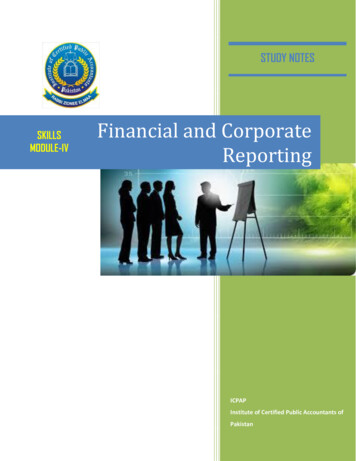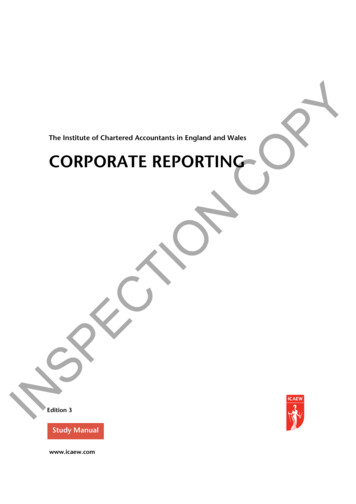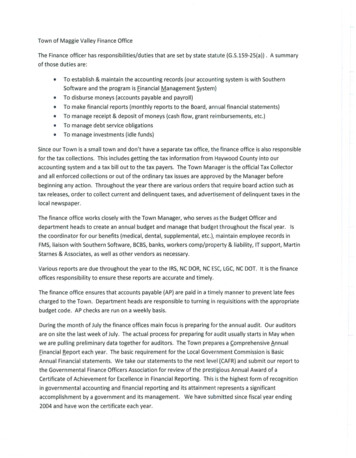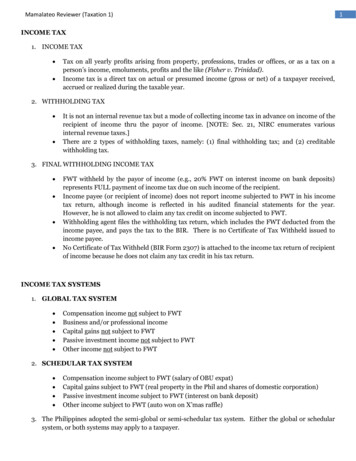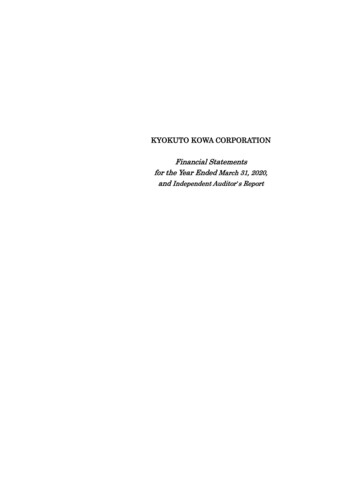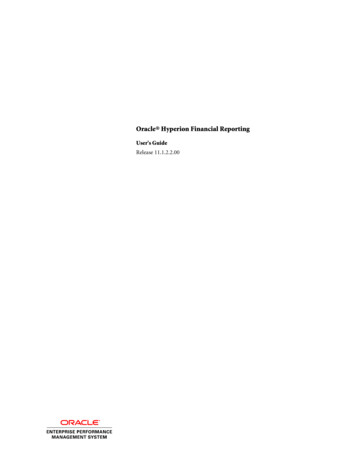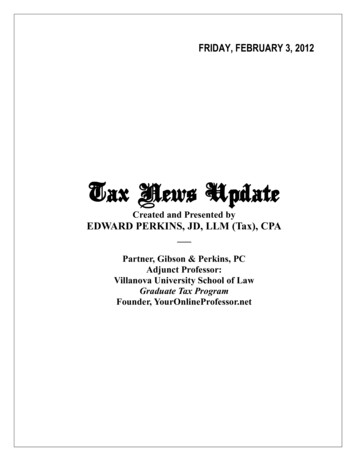
Transcription
Financial Reporting, Tax, and Real Decisions:Toward a Unifying FrameworkDouglas A. ShackelfordUniversity of North CarolinaJoel SlemrodUniversity of MichiganJames M. SalleeUniversity of ChicagoJuly 16, 2010Corresponding author: Joel SlemrodUniversity of MichiganAnn Arbor, MI 48109Email: jslemrod@umich.eduTel: 734-936-3914Fax: 734-936-8716Keywords: Taxation, accounting, corporate behavior, discretionJEL codes: H25, N41AbstractThis paper provides a first step toward joint evaluation of taxation and financial reportingin the standard economic analyses of corporate behavior. It develops a framework thatformalizes the idea that the attractiveness of some investment decisions is enhancedbecause they provide managers with discretion over the timing of taxable income and/orbook income. It then examines from this perspective several current examples of tax andaccounting issues.We are grateful for comments from Alan Auerbach, Dhammika Dharmapala, Jana SmithRaedy, Leslie Robinson, Terry Shevlin, Ro Verrecchia, Ryan Wilson and participants atthe Conference on the Intersection of Financial Accounting and Tax Policy, held inWashington, D.C. and at the NBER in Cambridge, MA. We thank Joanne Hsu, JennaMeints, and Kevin Markle for research assistance.
1.INTRODUCTIONContrary to the standard assumption of economic analysis, public corporationscare not only about the expected present value of their after-tax cash flows, but also abouthow these cash flows are depicted in their financial accounts.1 In this paper we provide aframework that unifies financial reporting, tax and real choices by introducing financialreporting considerations into a standard economics model of optimal, after-taxinvestment decisions. We view this as a first step toward joint evaluation of taxation andfinancial reporting in an optimizing model of corporate behavior. Ideally, it also providesa common language for a broad audience of both accountants and economists.The framework developed in this paper formalizes the idea that the attractivenessof some real decisions is enhanced because they provide managers with discretion overthe timing of taxable income and/or book income. Thus, to the extent managers valueflexibility in their tax and financial reporting, they are more likely to make real decisionsthat provide discretion. We present and discuss several examples that are consistent withour framework.The paper proceeds in the following manner. To motivate the model, Section 2provides some background about financial accounting and the differences between howincome and income tax are reported to the tax authority and to the investing public, andsummarizes the evidence that accounting matters for firm valuation and decisions.Section 3 discusses several examples of the interaction between financial accountingconsiderations and real decisions. In Section 4 we present our model, which is intendedto provide a common framework, as well as a common vocabulary, for economists andaccountants to discuss the effect of taxation. Sections 5 and 6 draw out the implicationsof the model for real and accounting decisions, respectively.We discuss theimplications for policy and research in Section 7 and offer concluding remarks in Section8.2.ACCOUNTING AND TAXATION OF CORPORATIONS2.11How It WorksWe discuss the evidence supporting this claim below.
Publicly-held U.S. companies have to provide financial information to at least twodifferent audiences, each of whom has a stake in assessing how much income is beinggenerated. One is a public accounting to the firm’s stakeholders: investors, creditors,customers, suppliers, employees, regulators, and rating services, among others. The otheris a nonpublic accounting to the taxing authorities, such as the United States’ InternalRevenue Service (IRS).The IRS can see the public financial statements, which helps the IRS to betterdetect any understatement of taxable income. In recent years, the value of seeing thepublic financial statements has been enhanced by the Schedule M-3 of the tax return,which requires the company to provide detailed information that reconciles theinformation on the financial statements to the information on the tax return. Althoughinvestors cannot see the tax return and firms are not required to disclose specificinformation from the tax return, e.g., taxable income, investors receive some informationabout taxes in the financial statements. This information in the financial statements maybe informative to both the IRS and investors. For example, FASB Interpretation No. 48(FIN 48), which requires firms to disclose the portion of their recognized tax benefits (forbook purposes) that they do not expect to retain if audited, provides investors withinformation about the firm’s tax risk and potentially aids the IRS in identifying firms foraudit (see FIN 48 analyses in Mills et al. (2007), Frischmann et al. (2008), Blouin et al.(2007) among others).2Firms report a different measure of income to each audience. The incomereported in financial reports may differ from taxable income for at least three reasons.First, there are explicit differences in the intent of the two reports. Financial statementsare designed to reduce information asymmetries through reliable and relevant disclosures.The tax return reflects policy that balances (often competing) economic objectives ofrevenue collection, equity, efficiency, and simplicity as well as political objectives toreward favored constituencies. Given the differences in the purposes of the financialstatements and the tax return, it is not surprising that the most useful measure of a firm’s2FIN 48 disclosures will become even more useful for the IRS, going forward. In April 2010, the IRSreleased in draft Form UTP (Uncertain Tax Position Statement), which will require corporations to reportconcise descriptions about the federal income tax positions for which they have recorded reserves underFIN 48 in its audited financial statements.2
profitability for shareholders usually differs from the most useful measure of profitabilityfor the taxing authorities.A second reason why book income and taxable income may differ is that whilefinancial accounting strives to record the underlying economics of a transaction in anobjective and verifiable way, much of the tax system is designed to induce or rewardparticular behavior. For example, for book purposes, the value of the firm’s equipment isdepreciated (an expense that reduces book income) each period based on estimates of theequipment’s deterioration. For tax purposes, the value of the firm’s equipment isdepreciated (a deduction that reduces taxable income) each period by a statutorilydetermined (without regard to actual deterioration) amount, which may be intentionallyaltered by legislation to encourage acquisition of equipment. Because the statutorydepreciation for tax purposes rarely equals the estimate for financial reporting of theequipment’s actual deterioration, book income and taxable income will differ.A third reason why book income and taxable income may differ is that there areincentives to mislead both the audience for the financial statements and the audience forthe tax return (e.g., the IRS) about ongoing operations. Both the financial statement andthe tax return are snapshots of what the corporation wants some audience—either theinvesting public or the IRS—to see. For example, in a given year, managers may haveincentives to look more profitable (see Healy and Wahlen (1999) for a review of studiesdocumenting manipulation of the financial reports). Returning to the depreciationexample, because determining deterioration is an imprecise process, managers have someleeway in recording book depreciation. Thus, book depreciation becomes a means ofmanaging book earnings, further creating differences in the two measures of income.Both the IRS and the U.S. Securities and Exchange Commission (SEC), whichregulates public financial disclosures in the U.S., have safeguards to protect againstmisleading reports. To ensure that it is receiving its appropriate share of profits, the IRSreceives millions of confidential—albeit potentially misleading—reports from businessesabout their earnings. Audit decisions are based on comparisons of tax returns across timefor the same taxpayer, across similar taxpayers in the same year, and with the informationin the firm’s financial statements.3
On the book side, the SEC receives financial statements from all publicly-tradedcorporations. The financial statements must conform to U.S. Generally AcceptedAccounting Principles (GAAP). Penalties for failure to comply include restating priorstatements, losing access to the public capital markets, and criminal proceedings againstmanagers.Finally, several recent studies document that book-tax divergence can be costlyincreasing both tax payments and financial reporting costs (see review in Graham et al.(2010). Mills (1998) provides an example of increased tax costs arising from book-taxdivergence. She uses confidential IRS data to demonstrate that firms with largerdifferences between book earnings and taxable income are more likely to be audited bythe IRS. Hanlon (2005) provides an example of increased financial reporting costsarising from book-tax divergence. Using financial statement disclosures, she finds thatthe more book income and taxable income diverge, the more investors trade as thoughthey consider the book earnings to be of lower ―quality‖ (i.e., unlikely to persist).2.2Why It Matters:Over the last 40 years, the primary accounting research questions have concernedwhich accounting information matters, why and for whom it matters, and how it affectsother economic choices.3 A recurring question in the literature is: To what extent willfirms expend resources to mitigate financial reporting costs?4 This question has beenexplored in numerous settings. Sometimes managers appear willing to expend non-trivialamounts of cash for ―better‖ accounting numbers; in other settings, the financialaccounting information appears to be of second order.Several of these studies have explored whether firms will remit more taxes, if itenables them to report better accounting earnings. To demonstrate that firms are(occasionally) willing to remit higher taxes in order to achieve certain financialaccounting goals, we briefly review book-tax tradeoffs in fraud allegations, equity-debtexchanges, debt covenants, inventory, and employee compensation. For a more3See extensive reviews in Kothari (2001), Dechow et al (2010), Armstrong et al. (2010), Beyer et al.(2010), among many others.4Financial reporting costs may be real or perceived and can pertain to income, shareholders’ equity, or anyother financial accounting disclosures; however, typically scholars and the capital markets focus on thecosts associated with reporting lower-than-expected book income.4
extensive review of this literature, see Shackelford and Shevlin (2001) and Hanlon andHeitzman (2010).Erickson et al. (2004) report that firms pay taxes on fraudulent profits,presumably to reduce the likelihood of their financial statements being identified asfraudulent. They examine 27 firms that restated their financial statements because ofSEC allegations of accounting fraud from 1996 to 2002. Allegations include reportingnonexistent and false revenues, recording fake inventory, and undertaking fraudulentschemes to inflate assets, revenues, and net income. The average firm in their studyoverstated earnings by 125 million and paid taxes on those profits of 12 million, equalto 1.3% of the average firm’s market value in the year prior to earnings overstatement.The income taxes paid per dollar of overstated earnings averaged 0.11, and the totalamount of taxes paid on overstated earnings by all firms in the sample was approximately 320 million on overstated earnings of 3.36 billion.Similarly, Dyreng (2009) finds that, as firms approach debt covenant violation,they make financial reporting choices that result in higher book profits. As with thefraudulent earnings, they pay taxes on these inflated profits. In other words, managersaccept the higher tax liability that comes with the higher book income in order to avoidthe costs associated with violating debt covenants. Dyreng (2009) estimates that theadditional taxes equal an increased cost of debt financing of between 13 and 23 basispoints, on average.Another setting where firms have been shown to opt for higher accounting profitsat the cost of higher taxes is compensation. Companies can deduct from taxable incomethe difference between the fair market value and the strike price for nonqualified stockoptions, but cannot deduct any costs associated with incentive stock options. Matsunagaet al. (1992) find that few firms choose to disqualify their incentive stock options(converting them into nonqualified stock options) even when doing so would lower theirtax liability. The reason is that disqualification also results ina charge to earnings. Examining firms after the Tax Reform Act of 1986, theyestimate those that did not qualify avoided a 2.3% reduction in reported earnings at a costof 0.6 million, on average. Francis and Reiter (1987) find similar book-tax tradeoffswith pensions.5
Engel et al. (1999) estimate how much cost firms are willing to incur simply togive the appearance of a better balance sheet. They study trust preferred stock (TRUPS),which is not treated as debt for financial accounting even though its dividends aredeductible for tax purposes. They find that the 44 firms that issued TRUPS and retireddebt from 1993 to 1996 reduced their debt/asset ratio by 13% at a cost of 10-43 million,on average, in issuance and retirement costs. As further quantification of the cost of abetter balance sheet, in their study of corporate divestitures, Maydew et al. (1999) showthat financial reporting incentives and cash constraints led many firms to incur taxliability related to the sale of companies, rather than opt for tax-free spin-offs.Finally, an extensive literature shows that firms choose inventory cost methodsthan result in higher taxes (see review in Shackelford and Shevlin, 2001). In inflationarytimes, last-in first-out (LIFO) inventory accounting minimizes the tax liability because itassigns the most recent costs (―last-in‖) to the newly produced (―first-out‖) goods.Nonetheless, even during inflationary periods, LIFO has never been widely adopted. Thereason is that firms using LIFO for tax purposes also must use it for book purposes,where the same matching results in lower accounting profits. In other words, inventorycosting choices are consistent with most firms preferring high accounting profits asopposed to lower taxes.These and other corporate choices make clear that managers often opt for higherbook earnings at the cost of increased taxes. Stated differently, many firms will notimplement tax plans that lower cash taxes paid, if they also reduce the reportedaccounting profits.Another large literature in accounting attempts to understand why firms placesuch heavy reliance on reported book profits. Two explanations dominate the literature.First, facing asymmetric information, investors have limited access to reliableinformation about the firm other than its audited, public financial statements. Thus,managers believe that the accounting information, particularly book income, is theprimary determinant of the capital market’s assessment of the firm’s performance and ismore important than cash flow, including the added cash than could result from lowertaxes. Second, many contracts rely heavily on accounting figures. Thus, even inprivately-held firms, accounting information can play a key role in compensation, bank6
loans, labor contracts and other important contracting relations. Not surprisingly, if thecontracts are based on financial accounting information, managers are apt to manage thebooks to maximize their utility. For example, Healy (1985) finds that executivesrewarded by accounting earnings-based bonuses make financial reporting choices thatincrease their compensation3.EXAMPLES OF THE VALUE OF DISCRETIONThis section provides examples that illustrate how taxes affect real and accountingchoices using the integrative framework detailed above. In each case, we see the valuecreated by a real decision that provides book and/or tax discretion. We also see that firmsthat value discretion, at the margin, will have incentives to make real decisions thatincrease their flexibility in reporting for both book and tax purposes. In the first example,the decision to operate in a low-tax country provides book discretion. In the secondexample, activities that result in uncertain tax positions (e.g., the transfer prices ofintercompany sales) create book discretion. In the third example, risky investmentsprovide book discretion. In the final example, incentives to increase book and taxdiscretion encourage firms to extend more credit than would otherwise be optimal.3.1Incentives to Invest AbroadThe first example of the value of discretion involves the incentive to investoutside the U.S. Although foreign subsidiaries of U.S. companies pay income tax in thejurisdictions where they operate, their parent companies generally do not pay any U.S.taxes on these foreign earnings until the profits are repatriated as dividends, at which timethey pay the U.S. tax due net of any applicable foreign tax credit for taxes paid to theforeign government (sometimes called the ―residual‖ U.S. tax). If the profits are neverrepatriated, no U.S. taxes are ever paid.For book purposes, firms must record the profits of their foreign subsidiaries inthe period when they are earned.5 However, under APB 23, managers have a choiceabout when to record the book tax provision related to the U.S. tax triggered byrepatriation. One option is to estimate the eventual U.S. tax and expense those taxes5An important distinction between book and tax is that the financial statements include the activities of allforeign subsidiaries, while the tax return generally excludes the profits of foreign subsidiaries.7
when the foreign profits are booked. By matching the tax provision to the foreignearnings, this option lowers current after-tax earnings, but leaves after-tax earningsunaffected when the dividend is paid.If the firm does not expect to repatriate the profits in the foreseeable future, thereis a second option. The firm can defer the expense until they decide to repatriate thefunds. If they never repatriate, then they never provide for the U.S. taxes. This approachresults in higher after-tax earnings in the year that the foreign profits are earned (becauseprofits are not reduced by an estimate of the U.S. taxes at repatriation). It also results in ahigher book tax provision (and lower after-tax book earnings) in the period when the firmdecides to repatriate the foreign profits.Because a firm can change its intentions about paying a dividend at any time, ithas the potential to shift some book income over time. Furthermore, a firm may decidethat profits whose U.S. tax provision has already been booked will not be repatriated afterall. If so, the tax expense that was booked for the U.S. tax in the past is removed fromthe books, shifting after-tax book income into that year.This discretion in financial reporting provided by foreign operations providesfirms with an (additional) incentive to locate in low-tax countries, e.g., tax havens. Thereason is that generally the less the foreign tax, the greater the U.S. tax, and thus thelarger the book tax provision that can be shifted across periods. Thus, GAAP encouragesinvestment in tax havens.To summarize, the tax policy of deferring the U.S. tax liability on the earnings offoreign subsidiaries provides the parent company with potentially valuable discretion infinancial reporting. Because the U.S. tax payment is deferred until repatriation, firms canexpense the tax when the profits are earned or whenever they decide that they willrepatriate the funds. This discretion provides an incentive to invest in low-tax countries.The discretion would be eliminated if a territorial system was adopted, or, as PresidentObama has suggested, deferral of the residual U.S. tax were repealed. In fact, the strongopposition by many U.S. multinationals to eliminating deferral may be based as much on8
the loss of flexibility in the reporting of the book tax expense as on the impact on cashtaxes paid (Graham et al, 2010).6In 2004, the book discretion arising from the tax law came full circle. TheAmerican Jobs Creation Act of 2004 provided a tax holiday to U.S. companies thatrepatriated earnings from their foreign subsidiaries. The amount of foreign earnings thatenjoyed a reduced tax rate was limited by the amount of ―permanently reinvested foreignearnings,‖ an accounting term for the amount of profits in foreign subsidiaries for whichthe firm has not recorded a residual U.S. book tax provision. In other words, the benefitof the tax holiday was affected by the way that the managers booked the tax law’sdeferral of U.S. taxes.This example demonstrates the intersection and joint determination of a realdecision (where to locate operations), a tax and financial decision (when to repatriate),and a book decision (when to record the book tax provision related to the repatriation).By investing abroad, the firm gains valuable tax and book discretion. By timing therepatriation, the firm gains valuable tax and book discretion (as well).The model of Section 4 formalizes the idea that the incremental discretion in thetiming of the book tax provision provides an incentive for some firms to invest in low-taxcountries. The lower the foreign tax rate, the larger the residual tax in the U.S. andconsequently, the greater the earnings management potential. Although the richness ofthis setting has long existed (see Collins, et al, 2001, and Krull 2004 for early studies),the 2004 tax holiday has led to a flurry of empirical studies regarding the book, tax andreal effects of deferral (see Faulkender and Petersen, 2009, Blouin and Krull, 2008, andDharmapala et al 2008, among others). Of these recent studies, none demonstrates theunifying framework developed in this paper better than Graham, et al (2009)’s survey oftax executives. They report that the ability to defer the income tax expense on theearnings of subsidiaries affects both the location of operations and the decision whetherto reinvest or repatriate those earnings. In fact, they find that managers value thefinancial reporting benefits of deferral as much as the cash taxes saved under deferral.6Referring to the possible loss of discretion in recording the residual U.S. tax if deferral were eliminated,Ralph Helmann, the lead lobbyist for the Information Technology Industry Council stated, ―It’s probablythe top issue right now for the tech community. This one hits the bottom line of companies more than anyother issue right now. We have to defeat it.‖ (Drucker, 2009).9
Blouin et al (2009) add that firms that elect APB 23 are less likely to repatriate becausedividends from foreign subsidiaries trigger income tax expense without any bookearnings. These findings corroborate our own private discussions with managers, whostress that both financial reporting and taxes are important factors in business locationdecisions. In short, the deferral under the tax law, the financial reporting requirementsunder GAAP, and the real decision about where to conduct business are comingled. Toexamine any part of this jointly determined decision and ignore the other factors mayresult in erroneous inferences about the factors driving business locations, tax decisionsand reporting choices.3.2Incentives to Engage in Transfer PricingThe second example of discretion involves uncertain tax positions that give rise tobook discretion. Although many transactions involve legal and factual ambiguity, wefocus on intercompany transfer pricing within a multinational corporation. As notedabove, financial statements are reported on a worldwide consolidated basis, but taxreturns generally exclude profits earned through foreign subsidiaries. Thus,multinationals can lower worldwide taxes by strategically setting their intercompanytransfer prices, for example by having corporations located in high-tax countries buy at ahigh price and sell at a low price when trading with affiliated corporations in low-taxcountries.Taxing authorities in high-tax countries attempt to defend their tax bases byestablishing transfer pricing rules that constrain this type of cross-country incomeshifting, and there is a continual cat-and-mouse game between multinationals and thetaxing authorities over transfer pricing. The most difficult transfer prices involveintangibles whose value is difficult to establish (e.g., brand names) and (whose taxableincome) can be easily shifted. Thus, tax minimization opportunities for transfer pricingare greatest among multinationals with high profit margins from intangibles, e.g.,research and development. The classic example is the pharmaceutical industry.The tax uncertainties associated with these companies provides some bookdiscretion. Since transfer prices are very difficult to establish and are subject to continualscrutiny by taxing authorities around the globe, it is very difficult to estimate the eventualworldwide taxes that will be paid following possible audits in multiple jurisdictions.10
Thus, companies typically accrue a liability for the uncertainty surrounding transferprices. Over time, resolution is reached about the tax liability, albeit sometimes yearslater. In the meantime, the uncertainty surrounding the eventual resolution of the taxliability gives the company some leeway in estimating its book tax provision. This issometimes referred to as ―cushion.‖ Historically it has been viewed as an importantmeans of managing earnings (Dhaliwal, Gleason and Mills, 2004; Blouin and Tuna,2006), i.e., shifting earnings across accounting periods.To summarize, engaging in transactions that inherently result in uncertainty aboutthe tax liability provides not only tax discretion (e.g., the ability to use transfer prices toshift income from high-tax countries to low-tax countries), but also provides bookdiscretion. Investments in intangibles that can cross jurisdictions carry the added benefitof facilitating both tax and earnings management.3.3Incentives to Hold Risky AssetsThe third example of discretion involves risky assets and how they can enable afirm to lower its book tax provision, boosting total assets and equity. Differences in thebook and tax bases of assets and liabilities result in deferred tax assets and liabilities.The largest source of deferred tax assets is net operating loss carryforwards, which havebeen expensed for book purposes but not yet deducted for tax purposes (Raedy, et al.,2010). When losses occur, firms can book an asset for the future tax savings that theywill receive when their net operating loss carryforwards are used to offset income in thefuture. However, if there is uncertainty about whether the carryforwards will ever beused, the firms must reduce the reported asset by a valuation allowance. Therefore, thenet deferred tax asset (deferred tax asset less valuation allowance) is the amount expectedto actually offset income in the future.To the extent firms can reasonably expect taxable income in the future, they arenot required to book a valuation allowance. This has the effect of lowering the book taxprovision, increasing the deferred tax asset, and thus increasing shareholders’ equity. Byinvesting in risky assets with higher expected yields, firms increase the likelihood ofgenerating taxable income in the future. Thus, risky assets provide discretion in therecording of the valuation allowance.11
This incentive to hold high-yield risky assets is particularly relevant for banks andinsurers because the rules governing regulatory capital are stricter than those for GAAP.In fact, for regulatory capital purposes, banks (life insurance companies) can only countas capital expected future taxable income if it is projected to be realized within the next12 (36) months. This provides an incentive for banks and insurers to hold a riskierportfolio than would otherwise be optimal because risky assets have higher yields,increasing the potential for higher taxable income, enabling the financial institution tolower its book tax provision. This incentive to hold high yield, risky assets has becomefar more important since the financial crisis left many companies with very large netoperating loss carryforwards. Those banks and insurers with the largest losses during thefinancial crisis have the greatest incentives to hold the riskiest portfolios, going forward,because risky assets give them the ability to reduce their book tax provision.73.4Incentives to Extend CreditThe final example of the value of discretion involves incentives to extend credit.Consider a firm with X in cash sales and Y in credit sales. Further assume that, afterconsidering that some of the credit sales will not be collected, collection costs and thetime value of money, the present value of the Y of credit sales equals X. That is, theexpected present value of the credit sales equals the value of the cash sales.If the firm would benefit from the ability to manage its earnings, then thediscretion provided by the credit sales makes them more valuable to the firm than thecash sales. The reason is that, at the time of the sale, the firm must estimate theuncollectible receivables and accrue (i.e., report as a current expense) the anticipated baddebts. Because estimates are, by definition, imprecise, firms have some leeway in theamount that they record for bad debts. If they wish to shift some income to (from) thisyear from (to) future years, they can lower (increase) the estimate of bad debts this year,wit
4 Financial reporting costs may be real or perceived and can pertain to income, shareholders’ equity, or any other financial accounting disclosures; however, typically scholars and the capital markets focus on the costs associated with reporting


